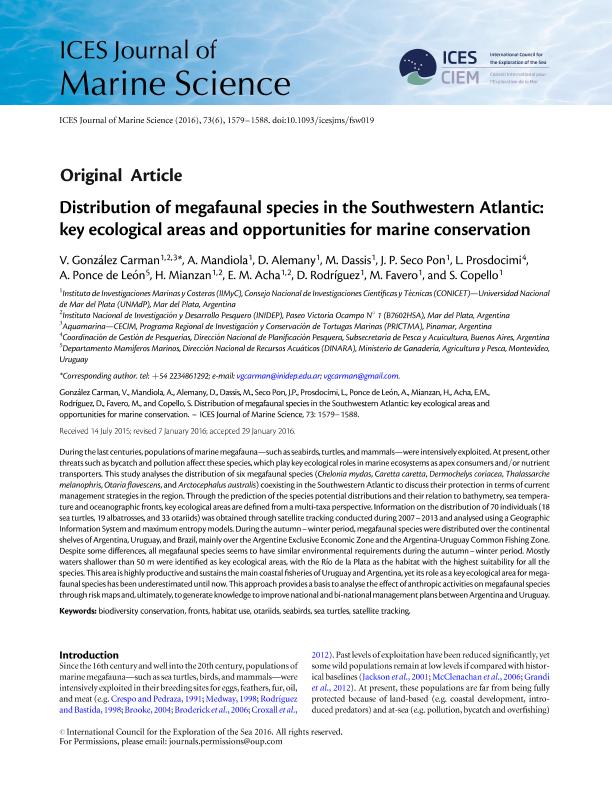Artículo
Distribution of megafaunal species in the Southwestern Atlantic: Key ecological areas and opportunities for marine conservation
González Carman, Victoria ; Mandiola, María Agustina
; Mandiola, María Agustina ; Alemany, Daniela
; Alemany, Daniela ; Dassis, Mariela
; Dassis, Mariela ; Seco Pon, Juan Pablo
; Seco Pon, Juan Pablo ; Prosdocimi, Laura; Ponce de Leon, Andres Hector; Mianzan, Hermes Walter
; Prosdocimi, Laura; Ponce de Leon, Andres Hector; Mianzan, Hermes Walter ; Acha, Eduardo Marcelo
; Acha, Eduardo Marcelo ; Rodriguez, Diego Horacio
; Rodriguez, Diego Horacio ; Favero, Marco
; Favero, Marco ; Copello, Sofía
; Copello, Sofía
 ; Mandiola, María Agustina
; Mandiola, María Agustina ; Alemany, Daniela
; Alemany, Daniela ; Dassis, Mariela
; Dassis, Mariela ; Seco Pon, Juan Pablo
; Seco Pon, Juan Pablo ; Prosdocimi, Laura; Ponce de Leon, Andres Hector; Mianzan, Hermes Walter
; Prosdocimi, Laura; Ponce de Leon, Andres Hector; Mianzan, Hermes Walter ; Acha, Eduardo Marcelo
; Acha, Eduardo Marcelo ; Rodriguez, Diego Horacio
; Rodriguez, Diego Horacio ; Favero, Marco
; Favero, Marco ; Copello, Sofía
; Copello, Sofía
Fecha de publicación:
06/2016
Editorial:
Oxford University Press
Revista:
ICES Journal of Marine Science
ISSN:
1054-3139
Idioma:
Inglés
Tipo de recurso:
Artículo publicado
Clasificación temática:
Resumen
During the last centuries, populations of marine megafauna - such as seabirds, turtles, and mammals - were intensively exploited. At present, other threats such as bycatch and pollution affect these species, which play key ecological roles in marine ecosystems as apex consumers and/or nutrient transporters. This study analyses the distribution of six megafaunal species (Chelonia mydas, Caretta caretta, Dermochelys coriacea, Thalassarche melanophris, Otaria flavescens, and Arctocephalus australis) coexisting in the Southwestern Atlantic to discuss their protection in terms of current management strategies in the region. Through the prediction of the species potential distributions and their relation to bathymetry, sea temperature and oceanographic fronts, key ecological areas are defined from a multi-taxa perspective. Information on the distribution of 70 individuals (18 sea turtles, 19 albatrosses, and 33 otariids) was obtained through satellite tracking conducted during 2007-2013 and analysed using a Geographic Information System and maximum entropy models. During the autumn-winter period, megafaunal species were distributed over the continental shelves of Argentina, Uruguay, and Brazil, mainly over the Argentine Exclusive Economic Zone and the Argentina-Uruguay Common Fishing Zone. Despite some differences, all megafaunal species seems to have similar environmental requirements during the autumn-winter period. Mostly waters shallower than 50 m were identified as key ecological areas, with the Río de la Plata as the habitat with the highest suitability for all the species. This area is highly productive and sustains the main coastal fisheries of Uruguay and Argentina, yet its role as a key ecological area for megafaunal species has been underestimated until now. This approach provides a basis to analyse the effect of anthropic activities on megafaunal species through risk maps and, ultimately, to generate knowledge to improve national and bi-national management plans between Argentina and Uruguay.
Archivos asociados
Licencia
Identificadores
Colecciones
Articulos(CCT - MAR DEL PLATA)
Articulos de CTRO.CIENTIFICO TECNOL.CONICET - MAR DEL PLATA
Articulos de CTRO.CIENTIFICO TECNOL.CONICET - MAR DEL PLATA
Articulos(IIMYC)
Articulos de INSTITUTO DE INVESTIGACIONES MARINAS Y COSTERAS
Articulos de INSTITUTO DE INVESTIGACIONES MARINAS Y COSTERAS
Citación
González Carman, Victoria; Mandiola, María Agustina; Alemany, Daniela; Dassis, Mariela; Seco Pon, Juan Pablo; et al.; Distribution of megafaunal species in the Southwestern Atlantic: Key ecological areas and opportunities for marine conservation; Oxford University Press; ICES Journal of Marine Science; 73; 6; 6-2016; 1579-1588
Compartir
Altmétricas



